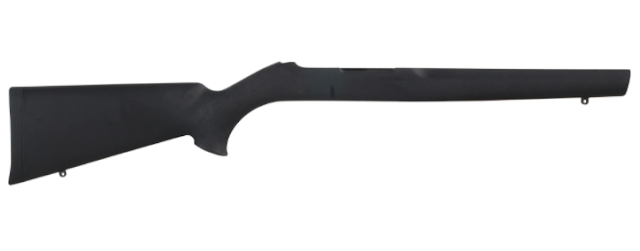There are a thousand and one ways to build a 10/22 rifle, but if you are searching for a way to save some weight, read on....
We'll start this off with looking at the weight of a standard 10/22 with a beech wood stock and 18.5" barrel, which is 5 lbs +/-, the 10/22 with a factory plastic stock is 4.4 lbs.
Let's take a look at the individual items:
The heaviest item on the 10/22 rifle is the barrel.
The factory 18.5" tapered barrel with sights installed weighs in at 29 ounces.
One option is to cut the factory barrel down to 16" (might want to make it 16 1/4" just in case :) ). This will save you a couple of ounces.
Some have even put their factory barrels on a lathe and trimmed them down. I don't know what affect this might have on the accuracy or precision of the barrel.
Another option is aluminum or carbon fiber barrels. These barrels feature a steel liner wrapped in aluminum or carbon fiber, often with a tensioning system to keep heat warp to a minimum, but these don't always save weight.
The 16.5" Volquartsen Ultralite barrel weighs just 15 ounces, it has a tensioned carbon fiber outer sleeve.
Dlask Arms also makes a 16.5" carbon fiber bull barrel, their barrel weighs in at 29.6 ounces, which is heavier than the stock tapered barrel.
Summit Precision also makes a carbon fiber barrel, there barrel tips the scales at 23.2 ounces
The next heaviest item on a 10/22 is the stock.
The factory beech wood stock weighs in at 28.9 ounces, while the factory plastic ones weigh just 21.4 ounces. We will use this as a baseline since most 10/22 owners start with a factory rifle.
First I checked the weight of the most popular 10/22 stocks:
Magpul X-22: 39.2 ounces
Hogue overmolded: 35 ounces
Stocky Stinger Thumbhole: 32 ounces
Pro Mag Arch Angel: 37.6 ounces
You can see that none of these options save weight, they all add weight.
What about the aluminum chassis? When looking at the weight you need to keep in mind that you need to add the buffer tube, butt stock and grip to the weights.
In order to keep things in perspective I weighed these three components (all A2 mil-spec components) and they weigh a combined 16 ounces +/-
Crazy Ivan has two new lightweight options, the standard Comp Chassis weighs 8.92 ounces, the Comp Lite is just 8.4 ounces
PMACA Chassis is listed as 14.2 ounces
The Kidd Tactical Chassis is close at 14.4 ounces
The Enoch Odin Chassis System is a bit lighter at 12 ounces
So if we take the lightest chassis (Crazy Ivan Comp Lite) at 8.4 ounces, add in the buffer tube, butt stock and grip we come up with 24.4 ounces, which is 3 ounces heavier than the factory plastic stock.
We could swap out the buffer tube and butt stock for a one piece "minimalist" style stock like this one from Battlearms Development
The next heaviest item on the 10/22 is the receiver. The factory receivers are made from cast aluminum and weigh just 7.9 ounces. I doubted that there was any alternatives that would be lighter so I checked and here is what I found:
Tactical Innovations Elite 22 receiver weighs 8.3 ounces, but comes with the scope rail, so it is probably close to the same weight as a factory unit with the scope rail attached.
The Volquartzen Superlite receiver is a bit lighter at 6 ounces, but costs $348

The next possible place to save weight would be the trigger housing. The factory trigger housings are currently made of plastic and weigh in at 1.7 ounces stripped. The factory aluminum ones weigh 3.5 ounces stripped.
I purchased a couple of these Pike Arms aluminum trigger housings and they weighed slightly more than the factory aluminum ones, probably due to their two piece design
I don't think there is any way to save weight by using anything other than the factory plastic trigger assembly.
The next heaviest item is the bolt.....but this may not be an area in which you could save any weight. The 10/22 uses a blow back operation and requires the bolt to be a minimum weight to operate properly....
Volquartsen offers a competition bolt, which features a titanium firing pin and an integral charging handle, both of which might save some weight, but weight savings is not listed as a benefit on their website, nor is the actual weight of this bolt
So here is the break down on a couple of possible lightweight builds:
1. Lightweight Aftermarket Components:
- Crazy Ivan Comp Lite Chassis: $169, 8.4 ounces
- Volquartsen Superlite Receiver: $348, 6 ounces
- Volquartsen Ultralite Barrel: $340, 15 ounces
- Battle Arms Stock Assembly: $199.95, 7.56 ounces
- A-2 style plastic grip: $2, 1.6 ounces
- Ruger BX Trigger assembly: $89.98, 4.8 ounces
- Factory Ruger bolt assembly (includes charging handle): $59.99, 7.1 ounces
Total Weight: 3.18 lbs. This is 1.82 pounds less than the factory wood stocked 10/22 and would cost you $920 more than a factory rifle (an increase of more than 332%) that comes out to $505 per ounce saved.
2. The Volquartsen Ultrallite with the Mod Shot stock, Volquartsen will sell this to you as a complete gun. The weight is just 3lbs 13oz, but the price starts at $1811.
3. Factory Ruger 10/22 Carbine with plastic stock Model # 1151:
Total Cost: $279.00
Total Weight: 4.4 lbs
4. Option 4 will use a combination of factory and aftermarket parts along with some home-done trigger/action work.
We will use a factory plastic stock, aftermarket aluminum receiver, a factory 18.5" barrel cut down to 16".
Our goal will be a 4lbs gun with a budget $250 or less.
Stay tuned.

















































